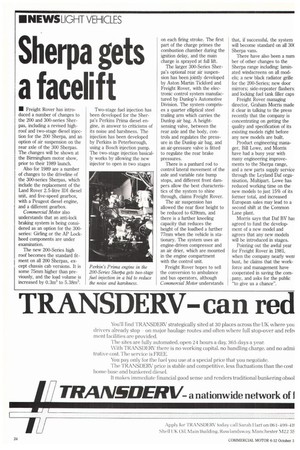Sherpa gets a facelift
Page 20

If you've noticed an error in this article please click here to report it so we can fix it.
• Freight Rover has introduced a number of changes to the 200 and 300-series Sherpas, including a revised highroof and two-stage diesel injection for the 200 Sherpa, and an option of air suspension on the rear axle of the 300 Sherpas. The changes will be shown at the Birmingham motor show, prior to their 1989 launch.
Also for 1989 are a number of changes to the driveline of the 300-series Sherpas, which include the replacement of the Land Rover 2.5-litre IDI diesel unit, and five-speed gearbox, with a Peugeot diesel engine, and a different gearbox.
Commercial Motor also understands that an anti-lock braking system is being considered as an option for the 300series: Girling or the AP Lockheed components are under examination.
The new 200-Series high roof becomes the standard fitment on all 200 Sherpas, except chassis cab versions. It is some 75m.m higher than previously, and the load volume is increased by 0.3m3 to 5.38m.
Two-stage fuel injection has been developed for the Sherpa's Perkins Prima diesel engine, in answer to criticisms of its noise and harshness. The injection has been developed by Perkins in Peterborough, using a Bosch injection pump. The two-stage injection basically works by allowing the new injector to open in two stages on each firing stroke. The first part of the charge primes the combustion chamber during the ignition delay, and the main charge is sprayed at full lift.
The larger 300-Series Sherpa's optional rear air suspension has been jointly developed by Aston Martin Tickford and Freight Rover, with the electronic control system manufactured by Dunlop's Automotive Division. The system comprises a quarter elliptical steel trailing arm which carries the Dunlop air bag. A heightsensing valve, between the rear axle and the body, controls and regulates the pressure in the Dunlop air bag, and an air-pressure valve is fitted to regulate the rear brake pressures.
There is a panhard rod to control lateral movement of the axle and variable rate bump stops, and different front dampers allow the best characteristics of the system to shine through, claims Freight Rover.
The air suspension has allowed the rear floor height to be reduced to 639mrn, and there is a further kneeling capacity that reduces the height of the loadbed a further 77mm when the vehicle is stationary. The system uses an engine-driven compressor and an air drier, which are mounted in the engine compartment with the control unit.
Freight Rover hopes to sell the conversion to ambulance and bus operators, although Commercial Motor understands that, if successful, the system will become standard on all 30( Sherpa vans.
There have also been a num ber of other changes to the Sherpa range including: laminated windscreens on all models; a new black radiator grille for the 200-Series; new door mirrors; side-repeater flashers: and locking fuel tank filler caps Freight Rover managing director, Graham Morris made it clear in talking to the press recently that the company is concentrating on getting the quality and specification of its existing models right before any new models are built.
Product engineering manager, Bill Lowe, and Morris have had a busy year with many engineering improvements to the Sherpa range, and a new parts supply service through the Leyland Daf organisation, Multipart. Lowe has reduced working time on the new models to just 15% of its former total, and increased European sales may lead to a second shift at the Common Lane plant.
Morris says that Daf BV haE agreed to fund the development of a new model and agrees that any new models will be introduced in stages.
Pointing out the awful year for Freight Rover in 1981, when the company nearly went bust, he claims that the workforce and management have cooperated in saving the company, and asks for the public "to give us a chance".






















































